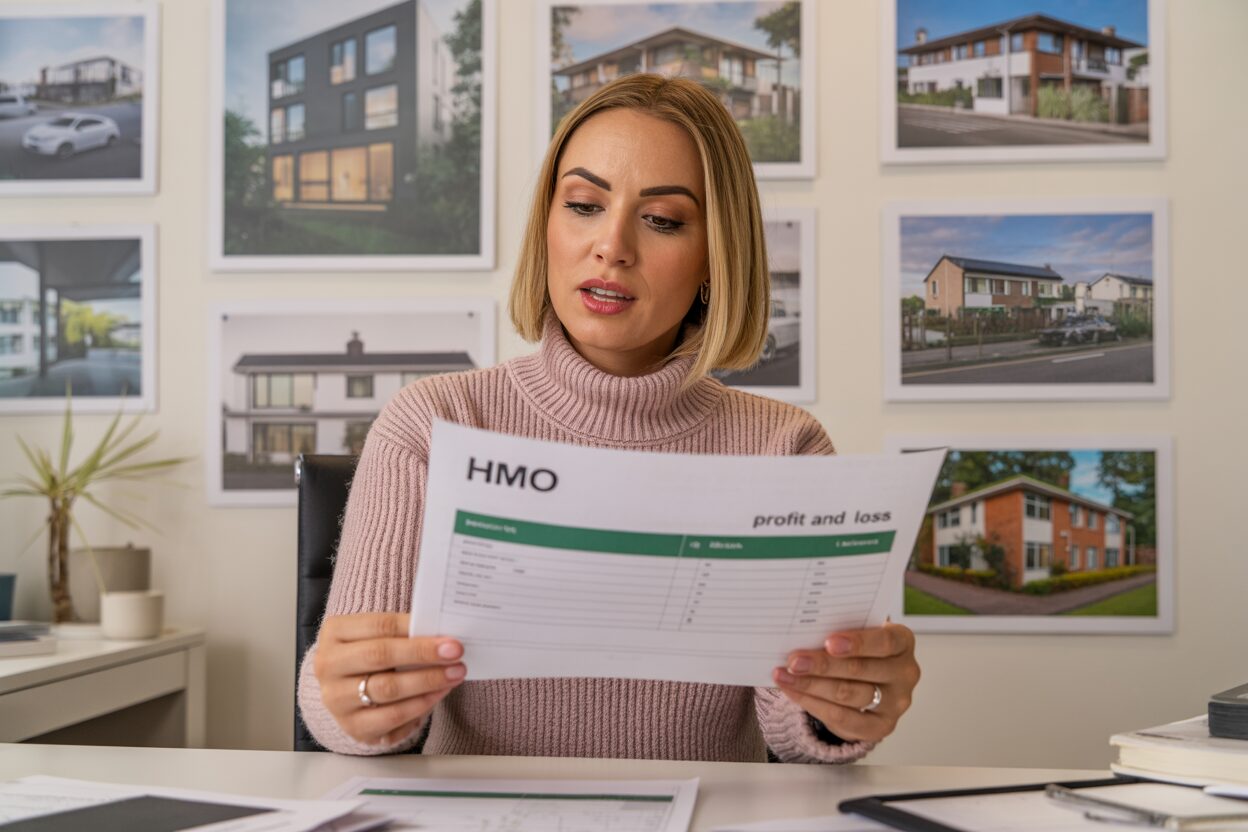
Both portfolio and small landlords ask us, “Is buy to let dead”, when they’re thinking about developing their long term investment strategy. What worries many investors are rising costs, unfavourable treatment by the taxman and new regulations governing buy-to-lets.
In this article, find out why there really is a future in buy-to-let. Discover the reasons behind some investor jitters in buy-to-let and why the fundamentals overcome them. Plus, why you should consider HMO investing if you have a larger sum of capital to invest upfront.
HMO Architects explainer: An HMO is a house or a flat occupied by at least three people forming more than one household, who share basic facilities like a kitchen or bathroom. In contrast, a traditional buy-to-let is rented to a single household, such as a family, on one tenancy agreement. [Related article: HMO VS Holiday Lets & Airbnb Property Investment)
Buy to let versus houses in multiple occupation: at a glance
Both buy to let and houses in multiple occupation are proven, long-term investments. Both offer the opportunity to earn ongoing rental income and build wealth over time. Before we go into more detail, here’s a quick overview of both:
| Single-let BTL | HMO (better) | |
| Typical return (gross yield) | 7.11%, highest since Feb 2011 (Paragon) | 10.4% (Landlord Today) |
| Monthly revenue streams per property | One household, one income stream | Income stream for every room let, resulting in higher overall rentals than buy-to-let |
| What if someone moves out? | All income stops until you re-let | If one person moves out, other renters still pay so room voids are less painful than whole property buy-to-let voids |
| How fast can you raise rent to reflect the market? | When you like but that may damage your relationship with a sitting tenant which may prompt a void period | As rooms change hands more often, you can vary your rent every time you rent a room out so different tenants pay different rates |
| Remortgage options | Usually based on local sales prices | You can support a bigger refinance with larger HMOs than just the value of the property, if your numbers stack up |
9 ways rental property owners have been hit in the last 10 years
Many of the worries our investors have are related to changes to the buy-to-let market in the last 10 years, especially from the government. Starting in 2016, George Osborne, the then Chancellor, began removing many landlord-friendly perks.
Since then, it’s become a lot harder to make money for a variety of reasons, including:
- Stamp Duty Land Tax: Stamp duty on landlords is much higher than back in 2015. You now pay an extra higher rates surcharge of 3 percentage points structured as bands that equate to 5%, 7%, 10%, 15% and 17% on portions above the standard rates from 1 April 2025 in England and Northern Ireland if buying a new residential property means you’ll own more than one. So, on a £300,000 property, you’ll pay £20,000 in tax for the purchase. It’s the same tax people pay on their second homes.
- Property values: Flat and house prices are now, on average, 50% higher than at the time of the Great Recession, according to the Halifax index. This has made the UK rental market tougher to break into.
- Mortgage-interest tax changes: You can no longer deduct BTL mortgage interest in full to reduce profits. Instead, you get a 20% tax credit (for individuals). This revised tax rule can turn a let you lost money on into a “profitable property”. (Different rules apply to limited-company ownership where interest remains deductible.)
- Interest rates: For a time, interest rates in 2016 were 0.25%. Now they’re 4%, coming off a high in July 2024 of 5.25%. That’s had a big effect on buy-to-let mortgage rates. In 2016, the two-year fix was 3.32% and five year 4.00% (Guardian). Today, it’s 4.88% and 5.21% respectively (Moneyfactscompare). To put flesh on that, annual interest on a 2-year fix in 2016 was £6,640. Today, that’s £9,760.
- Stricter lending tests: In 2016, mortgage approval rules tightened up. Lenders had to check that the rent comfortably covers the mortgage payment using stress tests. That limits how much you can borrow and pushes you to deal with higher rental yields.
- New renter law coming: Although not yet law, the Renters’ Rights Bill has landlords worried. It abolishes Section 21 and gives you much less power over whom you can rent your property out to.
- Energy standards rising: The government is proposing raising the rental minimum to EPC C by 2030. Right now, EPC E is the legal minimum. This might mean significant outlays on insulation, heating and control upgrades. Complying with the proposed new energy efficiency requirements will be prohibitively expensive for some landlords.
- Landlord insurance: The base level of £220 to £225 per year hasn’t changed much in the past five years. However, landlords whose property is a flood plain or high risk area can pay up to £1,100 a year.
- Selective licensing: The government gave councils the power to charge private landlords an extra fee. This is the selective licensing fee and it applies to buy-to-let properties as much as HMOs. Durham County Council charges £565 for this service.
Extra rules on the HMO property market
Landlords and developers in the HMO sector face the same rules as buy-to-let investors and more on top. They include:
- Licensing: You need an HMO licence for properties where five or more people from more than one household share a kitchen or bathroom. Some councils now also license smaller HMOs (additional licences). If your authority has additional licensing, you might have two licences to pay for.
- Planning restrictions: You need to apply for a sui generis use class if you want seven or more tenants in your HMO. You don’t need planning permission to turn a C3 dwellinghouse into a C4 HMO (three to six people) unless it’s in an Article 4 Direction of conservation area. If it is, expect to submit a full planning application before converting the property and all that comes with it like extra paperwork, fees and long approval times.
- Health and safety: You need to fit smoke alarms, add carbon-monoxide alarms where needed and maintain safe escape routes. Other responsibilities include an annual gas safety check and a full electrical check at least every five years. Remember to keep records and share the certificates with tenants when you move them in and after each periodic check. HMO inspectors will expect to see this paperwork when they come around to approve or renew a licence request.
- Size and quality restrictions: Bedrooms must meet minimum sizes and some councils ask for more. You also need enough bathrooms, toilets and kitchen space for the number of people living there. With so many people living in the same space, expect to invest in ventilation and soundproofing so your tenants can enjoy comfort, peace and quiet.
- Running costs: In most HMOs you, the owner, pay the council tax bill for the whole property. Since 1 December 2023 most HMOs in England are banded as a single dwelling for Council Tax and the owner is generally liable. Many HMO landlords also include gas, electric, water and broadband in the rent they charge. This can eat into your profits, especially if there are spikes in utility prices like in recent years.
Why property investment is still the right strategy
The UK is still desperately short of homes to buy and rent. There’s increasing demand for property but the consistent and decades-long lack of supply presents three major landlord benefits. They are rising rents, record yields and lenders competing for business.
Buy to let is still a great investment. But if you have the experience, budget and the know-how, you’ll benefit a lot more from HMOs.
Let’s look at the reasons investing in property is still the best way to secure financial freedom and comfort:
Buy to let: the case
Start and grow your buy-to-let portfolio for these reasons:
- Housing crisis: 4.7 million households rent privately in England, about 19% of all households. Social housing, even with great new schemes like Build to Rent, can’t meet today’s renters’ needs, let alone tomorrow’s. That’s especially true in high demand areas. There are 1.33 million people on the housing waiting list in the UK and a record 131,000 households in temporary accommodation. These are the market forces (and regrettable social realities) that underpin high demand for rent property and support ever-increasing rental payments.
- Rents are rising: ONS shows private rents up 5.9% year-on-year to July 2025. Zoopla reports new-let averages of £1,301 and expects modest growth ahead as the supply situation improves. Set your rent at the right rate and you’ll tie in cash flow from long term tenants.
- Yields are good again: Paragon Bank data shows yields at 7.11%, the best for 15 years. Fleet, another lender, saw yields range from 6.0% in London to a massive 9.2% in the North East. In a time of rising prices, this helps more landlords get a better return on the investment. [Related article: What is a Good Yield for a Rental Property?]
- Finance is available: The share of gross advances for BTL rose to 9.2% in Q2 2025, according to the Bank of England. Outstanding mortgages on fixed rates reached 1.44 million in Q1 2025, up 5% year on year. UKFinance reports in Q1 2025, the number of BTL loans advanced went up 38.6% year on year. Lenders still feel confident about the market.
- Limited company route: There are now over 400,000 buy-to-let companies on the register. Limited company property management structures allow you to claim mortgage interest tax relief. That option isn’t available to private landlords anymore. (Note: there are positives and negatives to owning properties through limited companies. Please consult with your accountant before making a decision).
- Lower CGT: A recently passed rule change cut the higher residential Capital Gains Tax rate from 28% to 24% from 6 April 2024. While it doesn’t make running properties cheaper, private landlords keep more of the profit when they sell up.
HMOs: why they’re the better option
If you have more money to invest, HMOs make sense. Here’s why:
- Higher incomes: Typical HMO gross yields are around 10.4% nationally. Some regions are a lot higher. That’s more you have to cover utilities, licensing, and compliance while still making a healthy profit.
- Lots more rent: SpareRoom’s Q2 2025 index shows average UK room rent £748 and London £980. Let’s say you have a six-bedroom HMO in London. That generates, before expenses, £5,880. Compare that with the average new buy-to-let asking rent of £2,249 in the capital.
- Risk spreading: If a family or a collection of students moves into a buy-to-let, great. That’s your rent covered. But when one goes, they all go. If one person leaves an HMO, the people remaining continue to pay their share.
- Portfolio growth: Renovate a buy-to-let and six months later, you might be able to refinance to unlock equity. Use that money to purchase your next property. The problem is lenders use comparable property values to decide how much you can borrow. With well-run larger HMOs, lenders often go much higher with the right financials.
HMO Architects: partners to new and experienced landlords
Britain’s going to require landlords in the coming years to provide enough housing for the population. Despite that, it seems like parliaments discuss new legislation to make the job of the landlord harder. However, the fundamentals of the sector are so strong that we’re experiencing record demand for our service.
Buy-to-lets as part of a great investment strategy. Work with HMO Architects on your next property investment and on building your portfolio. Here are three of our recent success stories for clients:
- Redmead Road, London (6 units): We turned an end-of-terrace into a six-bed C4 HMO for seven occupants, securing ground- and first-floor extensions plus a loft dormer. We use 3D modelling to resolve inner-room and light issues and accommodate council requests for roof amendments on the extension. Result: the property value went up from £550,000 to £950,000 and the rent from £1,400pcm to £8,400.
- Hobart Road, Cambridge (7 units): We designed a flexible Sui Generis scheme with a ground-floor, dormer extensions and a garden outbuilding to unlock the 7th bedroom. This was an amendment after an initial council challenge for the original amenity space. The value of the property rose to £950,000 from £550,000 and the rent to £8,400pcm from £2,200.
- Grove Lane, Ipswich (7 units): We maximised a corner-plot HMO with rear, loft and dormer extensions, prioritising en-suite rooms and street appeal. After a series of productive planning rounds with the council, we resolved issues relating to dorm visibility, drainage and landscaping. Result: value was £250,000 and now £450,000 with rent up to £4,200 from £1,400.
We’re investor-architects. Architects that create great outside and inside spaces while focusing on keeping costs down. The more we succeed, the better your returns. We offer a start-to-finish service including:
- Investment strategy calls: Ryan, our Investment, has worked on over 2,200 projects for clients. He was 17 when he began building his own extensive property portfolio. Share your ideas on growing a portfolio with him and get tailored guidance on a discovery call. [Related article: Ryan Windsor’s BRRR Method in Property]
- Feasibility study: Speak to Giovanni Patania, our Architect Director, about pre-buy and design feasibility studies. Know what you need to do to provide an HMO your target market wants while preserving and growing your yield.
- Planning permission: We deal with your council on planning permission and other issues like licensing to get your application through. We have a success rate of 97% across 200 councils on projects worth over £100m.
- End-to-end service: Access a range of key services under one roof. We provide architecture design and planning to building regs and interior design. The experts you need are all in one place.
- Wider network: Plug into our pool of trusted professionals. Access experts ranging from specialist builders to property development finance brokers when you need them.
Check out our detailed HMO legal FAQ and find out more about the true cost of unlicensed HMOs on our website. Discover whether HMOs, buy to lets or stocks and shares deliver the best return.
View our range of development finance case studies to see how we’ve helped clients turn their ideas into sound investments. Read customer stories on HMO, flat, holiday let and housing projects.
Call us on 01223 776 997 or email us directly.
Ryan Windsor, Development Director and co-founder of HMO Architect, brings over 15 years of specialised experience in HMO development to the table. Having consulted on nearly 2,200 projects, Ryan is a highly seasoned HMO landlord with a vast and influential property network. He began his real estate journey at just 17, rapidly amassing a wealth of experience that sets him apart in the industry. Beyond his professional successes, Ryan is passionately dedicated to giving back, leading numerous charitable initiatives that make a meaningful impact on local communities.




